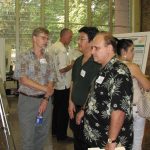Assessing Math, Science & Engineering Skills in Civil Engineering
This poster will present how the Civil Engineering B.S. program utilized multiple sources of evidence to evaluate the …


This poster will present how the Civil Engineering B.S. program utilized multiple sources of evidence to evaluate the …

This poster will present the results of efforts to develop a robust program for assessment of the graduate …

The poster describes the Department of Civil and Environmental Engineering’s process of assessing program outcomes. The steps in …

The poster describes the Department of Civil and Environmental Engineering’s process of assessing program outcomes. The steps in …